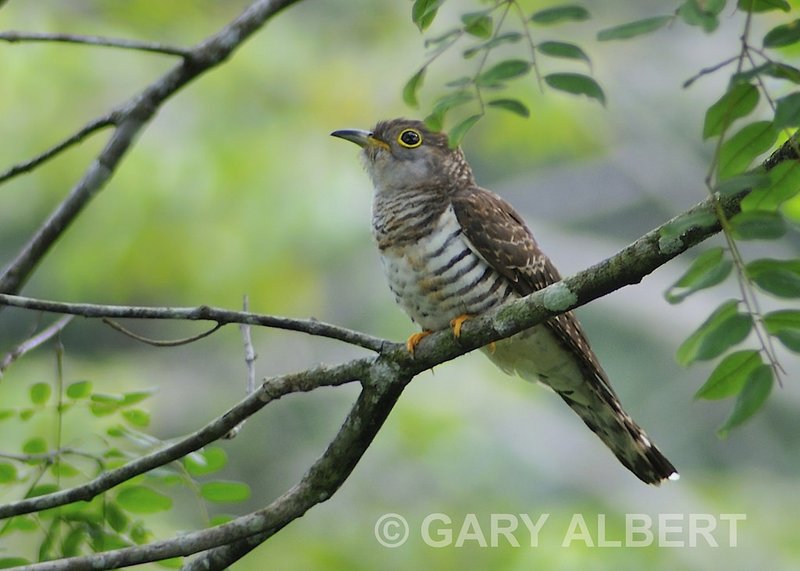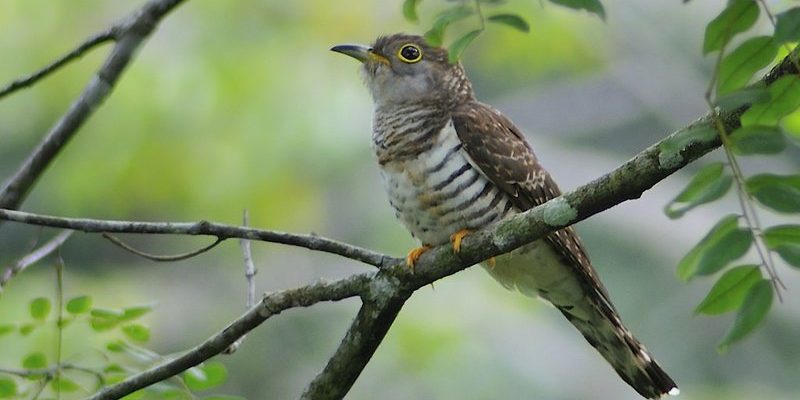
The Indian Cuckoo is a fascinating bird that captures the imagination of birdwatchers and nature lovers alike. With its sleek body and melodious calls, this bird stands out in the avian world. Imagine meeting a charismatic stranger at a party who draws everyone’s attention with their stories and laughter—that’s the Indian Cuckoo for you in the bird kingdom!
Migratory by nature, the Indian Cuckoo can be found in various habitats across the Indian subcontinent. It’s known for its distinctive call, often described as a melodic “coo-coo” that echoes through the forests, fields, and gardens. This call is not just for show; it plays a vital role in their mating rituals. It’s like a love song, inviting potential partners to join in a duet of nature.
Despite its beauty, the Indian Cuckoo has some peculiar habits that make it quite unique. For instance, it is a brood parasite, which means it lays its eggs in the nests of other birds. Imagine dropping your keys in someone else’s bag and hoping they take care of them—the Indian Cuckoo relies on other birds to raise its young! Let’s delve deeper into the life and habits of this captivating creature.
Physical Characteristics
The Indian Cuckoo boasts a range of features that make it easy to recognize. Typically, this bird measures around 32 to 34 cm in length, with a wingspan that spans approximately 45 cm. Its plumage varies between male and female, with males generally having a more vibrant coloration, adorned with striking patterns that help them blend into their surroundings. Think of it as nature’s way of providing a stylish camouflage!
One of the most notable features of the Indian Cuckoo is its long tail, which is often held upright while it perches, giving it a distinctive profile. The bill is slender and slightly curved, perfectly adapted for its diet, which mainly consists of insects and caterpillars. Whether it’s a juicy caterpillar or a fluttering butterfly, the Indian Cuckoo is an agile predator, swooping down to catch its meal with remarkable precision.
In terms of coloration, males typically display a slate-gray hue with a hint of brown, while females may have more brownish tones. The contrast between their feathers and the green foliage of their habitats allows them to evade predators while also being a sight to behold during the breeding season. The Indian Cuckoo’s appearance is not just about beauty; it’s about survival, cleverly designed by nature itself.
Habitat and Distribution
The Indian Cuckoo thrives in a variety of environments, from tropical rainforests to scrub forests, and even urban areas. You might find them in gardens where they can easily find food and shelter. This versatility in habitat choice showcases their adaptability, allowing them to thrive in different ecosystems. Picture a skilled traveler who feels at home whether in a bustling city or a serene countryside—that’s the Indian Cuckoo!
This bird is primarily found throughout the Indian subcontinent, with its range extending from India to Bangladesh, Nepal, and even parts of Southeast Asia. During the summer months, they can be spotted in higher elevations as they migrate for breeding, seeking warmer climates in the non-breeding season. Their migratory patterns reflect a unique instinct to follow the climate, much like we choose our vacation spots based on the weather!
| Size | 32-34 cm |
| Wingspan | Approximately 45 cm |
| Diet | Insects, caterpillars |
| Habitat | Tropical forests, scrublands, urban areas |
| Lifespan | Up to 6 years |
Behavior and Communication
Indian Cuckoos are renowned for their intriguing behaviors, especially regarding communication. Their calls are not only beautiful but serve as a means of establishing territory and attracting mates. The males, in particular, have a unique courtship display, where they sing their distinctive “coo-coo” song while perched prominently to attract females. It’s like a musical performance that draws in an audience!
During the mating season, these birds become more vocal, filling the air with their calls that resonate through the trees and fields. Not just a simple sound, their calls have variations, conveying different messages to one another. Imagine having a special language with your friends that only you all understand—this is how Indian Cuckoos communicate with elegance.
When it comes to foraging, Indian Cuckoos display remarkable hunting skills. They can often be seen fluttering among the foliage, stalking their prey with a stealthy grace. You might catch them flicking their tails as they search for caterpillars or insects, showcasing their agility and keen eyesight. Their foraging habits are a blend of patience and precision, much like how we might approach a tricky situation in life.
Breeding and Nesting Habits
The breeding habits of the Indian Cuckoo are perhaps one of the most fascinating aspects of their life cycle. As a brood parasite, the female Cuckoo lays her eggs in the nests of other birds, typically those of host species like the Indian Robin or the Common Tailorbird. This is where things get quite interesting! The female Cuckoo often removes one of the host’s eggs to make room for her own, ensuring that her offspring has the best chance of survival.
Once the Cuckoo egg hatches, the chick exhibits some remarkable behavior. It instinctively pushes the host’s eggs or chicks out of the nest—an act of survival that ensures it receives all the care and food from the unsuspecting foster parents. Imagine being the sole recipient of all the attention and resources in a bustling household—that’s the life of a Cuckoo chick!
This parasitic strategy raises questions about the survival of host species, but nature has a way of balancing things out. Many host birds have developed strategies to cope with Cuckoo brood parasitism, which creates a fascinating interplay between different species. It’s a real-life game of survival, displaying the cunning nature of the Indian Cuckoo!
Conservation Status
Currently, the Indian Cuckoo is not considered endangered. However, like many bird species, it faces threats from habitat loss due to urbanization and deforestation. As humans continue to expand into natural areas, the delicate balance of ecosystems is often disrupted. Think of it as a game of Jenga—each piece that is removed can cause the whole structure to become unstable.
Conservation efforts are essential to ensure that this beautiful bird continues to thrive. Preserving their natural habitats and creating awareness about their role in the ecosystem can help maintain their populations. Birdwatching communities and conservation groups play a vital role in protecting these habitats, much like friends rallying together to support a cause they believe in.
As we learn more about the Indian Cuckoo and its fascinating behaviors, let’s remember that every species contributes to the web of life. By supporting conservation efforts, we can ensure that future generations will have the opportunity to hear the enchanting calls of the Indian Cuckoo echoing through the trees.
FAQ
What does the Indian Cuckoo eat?
The Indian Cuckoo primarily feeds on insects, with a particular fondness for caterpillars. Their diet also includes other small invertebrates, and they play a crucial role in controlling insect populations in their habitats. This diverse diet reflects their adaptability as they thrive in various environments.
How can I identify an Indian Cuckoo?
Identifying an Indian Cuckoo can be quite easy if you pay attention to its features. Look for its long tail, slender body, and distinctive grayish-brown plumage. The males have a more vibrant coloration, while females are often browner. Additionally, listening for their unique “coo-coo” calls can help you spot them in the wild.
Are Indian Cuckoos migratory birds?
Yes, Indian Cuckoos are migratory birds. They migrate to higher elevations during the breeding season and return to lower altitudes in the non-breeding season. This migratory behavior is driven by environmental conditions, as they seek suitable habitats to thrive.
What other birds are known for brood parasitism?
Besides the Indian Cuckoo, several other bird species are known for brood parasitism. The Common Cuckoo, Brown-headed Cowbird, and certain species of honeyguides also engage in this behavior. Each has unique strategies for laying eggs in the nests of other birds, showcasing the variety in nature’s survival tactics.
How long do Indian Cuckoo eggs take to hatch?
Indian Cuckoo eggs typically take about 10 to 14 days to hatch. The time can vary depending on environmental conditions and the specific host species. Once hatched, the Cuckoo chicks are particularly demanding, requiring constant feeding from their foster parents.
What is the lifespan of an Indian Cuckoo?
The average lifespan of an Indian Cuckoo is around six years in the wild. However, like many birds, their life expectancy can be affected by factors such as predation, habitat loss, and environmental changes. Providing suitable habitats is essential for helping these birds thrive for longer periods.
Do Indian Cuckoos migrate alone or in groups?
Indian Cuckoos typically migrate alone rather than in large flocks. Their solitary migratory behavior allows them to adapt more easily to changing environmental conditions. While you may spot a few together during migration, they generally prefer to travel independently.
How can I help protect Indian Cuckoos?
You can help protect Indian Cuckoos by supporting local conservation efforts that aim to preserve their habitats. Planting native trees and creating bird-friendly gardens can provide essential resources for these birds. Additionally, educating others about the importance of biodiversity will help raise awareness about protecting these magnificent creatures.
Are Indian Cuckoos found in urban areas?
Yes, Indian Cuckoos can be found in urban areas, especially where gardens and green spaces exist. They adapt well to different environments, making them a common sight in cities that provide food sources like insects. Urban parks can be great spots for observing these intriguing birds!
What role do Indian Cuckoos play in their ecosystem?
Indian Cuckoos play an important role in their ecosystems by helping control insect populations. By feeding on various insects and caterpillars, they maintain a balance within the food web. Additionally, as brood parasites, they contribute to the dynamics of bird populations in their habitats.

